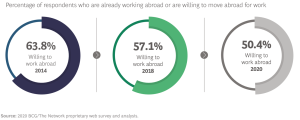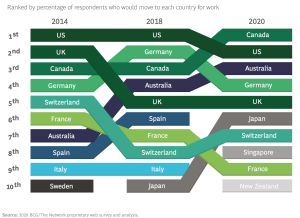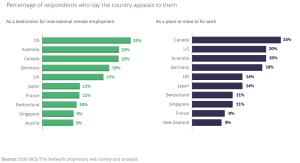The pandemic has reshaped our views of work in one way or another. One of the interesting new trends on the rise is virtual mobility or remote international work.
Since last year, companies have announced more flexible policies that let employees work from more locations — including cities without offices. Spotify went so far as to encourage workers to choose not only their work location (home or office) but also their country.
Before we get into the impact of virtual team trends, are you aware of what virtual mobility is? When someone brings up the topic, they’re likely talking about the new ability in many workplaces to work from anywhere in the world. Virtual mobility is about being able to take on remote work, both within the country and internationally.
One of the virtual team trends associated with virtual mobility is a set of more flexible policies in place at work. Employees can choose to go anywhere they want and get their tasks done. This might mean going to big cities within the country or even small towns outside of the country. Even places without offices are options for virtual mobility.
You may have heard the term “digital nomad” before. The increase in digital work environments has made a new lifestyle one of the virtual team trends of today. Digital nomads are people who work remotely from other countries. They use technology to connect with their teams while living anywhere they like.
These virtual team trends, and others, are more common than ever following the COVID pandemic. All sorts of industries went digital with work done online. As more companies adopt remote workplaces, employees can choose where they want to be while keeping the jobs they already enjoy
Boston Consulting Group (BCG) conducted a study of 209,000 people in 190 countries and uncovered big shifts in the map of global mobility:
(1) Willingness to move abroad has declined by 13 percentage points since 2014.
The travel restrictions during the pandemic have accelerated this decline. Relocation willingness has also been affected by the trend toward remote work.

(2) The order on the list of the top-ten work destinations has changed.
The changes largely reflect different countries’ success in managing the pandemic. Many European countries have disappeared from the list. There has been a popularity boost for Japan, Singapore, and New Zealand. The US lost the top spot for the first time.

(3) Appeal of virtual mobility has significantly increased.
57% of respondents are willing to work remotely for an employer that doesn’t have a physical presence in their home country. This level is well above the proportion who are open to physical relocation.
The US returns to the top position when the question is about virtual work.

These shifts create new opportunities and challenges for companies. Teams will likely become more geographically dispersed and global. Leaders need to get ready.
According to Dr. Tsedal Neeley, Professor of Business Administration at Harvard Business School, the main difference between global teams that work and those that don’t lies in the level of social distance—the degree of emotional connection among team members.
Mitigating social distance is the primary management challenge for a global leader.
- In this HBR article, Dr. Tsedal Neeley offers a framework for managing social distance.
Big Shifts in the Map of Global Mobility
A study done by the Boston Consulting Group shows how virtual team trends have changed. The most popular place to work is no longer the United States, and many people don’t want to move elsewhere to work. The whole state of work has changed since the pandemic. The willingness to move abroad has dropped by 13% since 2014.
In addition, the top work destinations have been altered. In 2014, the list looked like the following:
- The United States
- The United Kingdom
- Canada
- Germany
- Switzerland
- France
- Australia
- Spain
- Italy
- Sweden
Over the past six years, many of the same countries have been listed, but not all. Some have disappeared from the top 10, others have been added, and all of them have moved positions. As of 2020, the top ten work destinations include:
- Canada
- The United States
- Australia
- Germany
- The United Kingdom
- Japan
- Switzerland
- Singapore
- France
- New Zealand
Many of the countries that struggled to contain the pandemic, like Spain, Italy, France, and the United States, are considered less desirable. On the other hand, places that have done well with the pandemic, such as New Zealand, Singapore, and Japan, have become more desirable for workers.
Thoughts about remote work have also changed in the last few years. About 57% of respondents noted that they’re happy to work remotely from a company that isn’t in place in their own country. This is a much larger number of individuals than those who are willing to physically relocate somewhere for a position.
Impact of Geographically Dispersed Teams
Living far away from a business used to make it impossible to work for them. That’s no longer the case. Today, we have videoconferencing and other software as virtual team trends that make the process easier. That isn’t to say that there are no disadvantages to having a geographically dispersed team. However, it’s important to consider both the pros and cons.
Advantages
One of the advantages of a global team is the amount of talent available. There’s no need to stick to a city, state, or even country to find qualified team members. Instead. You can look everywhere for someone who meets or exceeds the job qualifications. Taking them on as virtual team members lets you use those skills without paying for relocation.
Virtual team trends also show that managers who make employees happy will likely keep them in place longer. These workers are also often more productive throughout the workday. So how do you make them happy? Give them a great work-life balance and flexibility to enjoy. Virtual employment can improve the happiness of everyone on a team.
Rather than working a typical 9-to-5 schedule, remote work opens up your options. You can have the office open at all hours when people work across the globe. This can be a huge advantage for companies that benefit from additional hours. Hiring people in new places lets you stay open longer and provide what customers need from you.
Disadvantages
When teams are scattered, it can be harder to create a sense of belonging and engagement. It takes more work to ensure workers are happy and don’t feel isolated. Not seeing each other every day can have effects on engagement rates. As engagement drops, some employees may be less inclined to offer to help out or take on new projects.
If most of the employees are outside of an office, this can also make it hard to ensure the workplace is productive. Most people who work remotely are doing so from a home, hotel, or other location. A personal desktop or laptop is the main equipment used. However, kids, pets, and household tasks can distract from the job.
In addition, those who work remotely may communicate mostly through direct messages or emails. This leaves things open to miscommunication since it’s hard to gauge your tone. No intonation or body language is seen, so people may misinterpret the way someone is saying something. The good news is that video conferencing can help with that.
Tips for Managing a Global Team
The truth is that global teams can work. The fact that the term “virtual team trends” exists and is used regularly illustrates that. However, as you now know, there are benefits and disadvantages to managing a team around the globe. So how do you incorporate the virtual team trends that work to manage a team well?
Consider social distance. The truth is that a team with an emotional connection is more likely to succeed than one where workers feel lonely and isolated. Fostering an atmosphere of connection and belonging is essential for a global team.
You should also think about the perception of power. What does that mean? If about 75% of the team members are in a specific location, while the other 25% are across the globe, people notice. Virtual team trends show that it makes it seem as if the 75% has most or all of the power. This is something to be avoided.
Make sure the company has a common purpose and empathy is used to breed positive interactions. Having unstructured time for people to chat can also be useful. As a leader, make sure you use technology that lets you communicate well. Many will follow your lead. You could make virtual team trends of your own.


